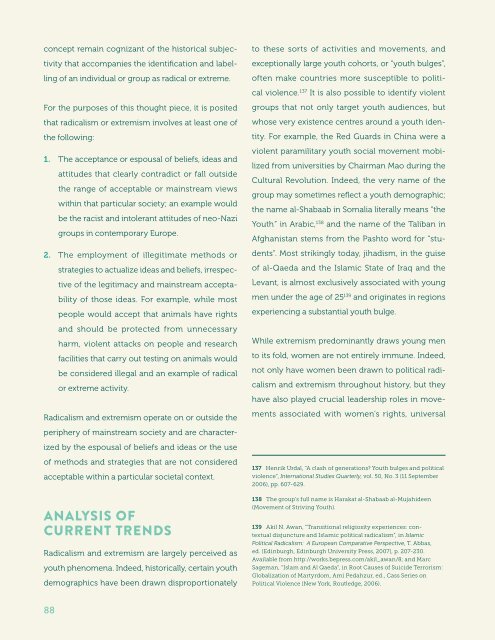YOUTH CIVIC
JieguI2U
JieguI2U
Create successful ePaper yourself
Turn your PDF publications into a flip-book with our unique Google optimized e-Paper software.
concept remain cognizant of the historical subjectivity<br />
that accompanies the identification and labelling<br />
of an individual or group as radical or extreme.<br />
For the purposes of this thought piece, it is posited<br />
that radicalism or extremism involves at least one of<br />
the following:<br />
1. The acceptance or espousal of beliefs, ideas and<br />
attitudes that clearly contradict or fall outside<br />
the range of acceptable or mainstream views<br />
within that particular society; an example would<br />
be the racist and intolerant attitudes of neo-Nazi<br />
groups in contemporary Europe.<br />
2. The employment of illegitimate methods or<br />
strategies to actualize ideas and beliefs, irrespective<br />
of the legitimacy and mainstream acceptability<br />
of those ideas. For example, while most<br />
people would accept that animals have rights<br />
and should be protected from unnecessary<br />
harm, violent attacks on people and research<br />
facilities that carry out testing on animals would<br />
be considered illegal and an example of radical<br />
or extreme activity.<br />
Radicalism and extremism operate on or outside the<br />
periphery of mainstream society and are characterized<br />
by the espousal of beliefs and ideas or the use<br />
of methods and strategies that are not considered<br />
acceptable within a particular societal context.<br />
ANALYSIS OF<br />
CURRENT TRENDS<br />
Radicalism and extremism are largely perceived as<br />
youth phenomena. Indeed, historically, certain youth<br />
demographics have been drawn disproportionately<br />
to these sorts of activities and movements, and<br />
exceptionally large youth cohorts, or “youth bulges”,<br />
often make countries more susceptible to political<br />
violence. 137 It is also possible to identify violent<br />
groups that not only target youth audiences, but<br />
whose very existence centres around a youth identity.<br />
For example, the Red Guards in China were a<br />
violent paramilitary youth social movement mobilized<br />
from universities by Chairman Mao during the<br />
Cultural Revolution. Indeed, the very name of the<br />
group may sometimes reflect a youth demographic;<br />
the name al-Shabaab in Somalia literally means “the<br />
Youth” in Arabic, 138 and the name of the Taliban in<br />
Afghanistan stems from the Pashto word for “students”.<br />
Most strikingly today, jihadism, in the guise<br />
of al-Qaeda and the Islamic State of Iraq and the<br />
Levant, is almost exclusively associated with young<br />
men under the age of 25 139 and originates in regions<br />
experiencing a substantial youth bulge.<br />
While extremism predominantly draws young men<br />
to its fold, women are not entirely immune. Indeed,<br />
not only have women been drawn to political radicalism<br />
and extremism throughout history, but they<br />
have also played crucial leadership roles in movements<br />
associated with women’s rights, universal<br />
137 Henrik Urdal, “A clash of generations? Youth bulges and political<br />
violence”, International Studies Quarterly, vol. 50, No. 3 (11 September<br />
2006), pp. 607-629.<br />
138 The group’s full name is Harakat al-Shabaab al-Mujahideen<br />
(Movement of Striving Youth).<br />
139 Akil N. Awan, “Transitional religiosity experiences: contextual<br />
disjuncture and Islamic political radicalism”, in Islamic<br />
Political Radicalism: A European Comparative Perspective, T. Abbas,<br />
ed. (Edinburgh, Edinburgh University Press, 2007), p. 207-230.<br />
Available from http://works.bepress.com/akil_awan/8; and Marc<br />
Sageman, “Islam and Al Qaeda”, in Root Causes of Suicide Terrorism:<br />
Globalization of Martyrdom, Ami Pedahzur, ed., Cass Series on<br />
Political Violence (New York, Routledge, 2006).<br />
88


